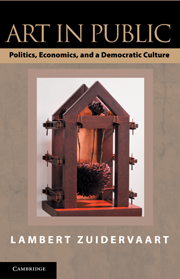6 - Countervailing Forces
Published online by Cambridge University Press: 05 June 2012
Summary
Without a vision, the people perish.
Proverbs 29.18Previous chapters have proposed that participation in the public sphere and the civic sector is what justifies government protection and support for art in public. Art in public is a culturally mediated and societally constituted sociocultural good whose imaginative disclosure draws nuanced attention to issues and interests of public concern. It can do so because of its role in civil society, especially at the interfaces of civil society with political and economic systems. These interfaces are, respectively, the public sphere and civic sector. Organizations fostering art in public need government protection and support not only because political and economic systems threaten civil society but also because these systems require a robust civil society in order to function properly.
Here, however, difficult questions rise. How viable is civil society under current conditions? How viable are the public sphere and the civic sector? What are the prospects for arts organizations that do not simply follow the dictates of bureaucratized administrative states and an increasingly globalized capitalist economy? What if appropriate arts organizations do not exist or will soon disappear? What if the public sphere is the “phantom” Bruce Robbins and others claim it to be? What if the civic sector does not embody the social economy that Van Til and Rifkin attribute to it? In these cases my attempt to reconceptualize the arts and civil society would lose its point, and the project of promoting art in public would seem futile. We need to explore the viability of the proposed conception and of its implicit agenda under current conditions.
- Type
- Chapter
- Information
- Art in PublicPolitics, Economics, and a Democratic Culture, pp. 170 - 204Publisher: Cambridge University PressPrint publication year: 2010



